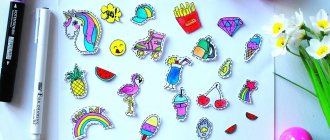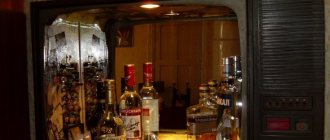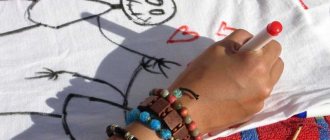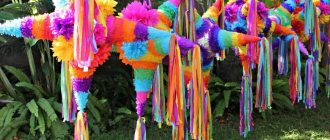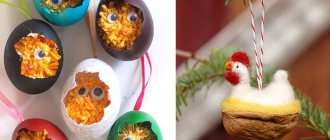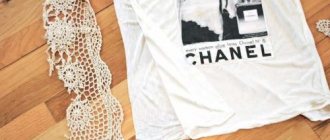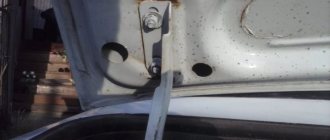A bit of geography
Beneath the ground lies magma, molten rock that seeps to the surface through small holes in the ground or erupts through craters. Volcanoes are located on the border of tectonic plates, in the mountains. But there are known cases of their appearance in areas with flat terrain and over a short period of time. Active volcanoes are generally portrayed as huge and regular in shape, but this is not the case; in fact, there are different types. Volcanoes can be tall or very small and disproportionate.
An eruption proceeds as follows: gases and magma located underground are pushed upward under strong pressure. Sometimes there are even explosions; sometimes volcanoes erupt lava, gushing like geysers.
Experiments with oil
Carefully pour two liquids into the bottle that do not mix well with each other - the lighter one of the latter, so that it ends up on top. The easiest way is to take plain water (for brightness, lightly tint it with jam), and pour sunflower oil on top of it
The bottle will look like a layer cake with a very clear boundary between water and oil. Rock the bottle gently. Small waves will run from above, along the layer of oil, but we are only interested in what happens at the boundary between oil and water
With slow rocking, this boundary will begin to curve smoothly - waves will also flow along it, only slower and steeper than those on the surface. These are internal waves - they exist in the thickness of the liquid, or more precisely, at the boundary where liquids with different densities meet.
Salt dough volcano
For the experiment you need a minimum of materials and a little patience. To make a volcano model with your own hands, you will need:
- Tray;
- Plastic bottle;
- Food paint;
- Foil;
- Dishwashing liquid;
- Salty dough;
- Vinegar;
- Baking soda.
After we have found everything we need, we begin modeling. Let's get started by following the instructions:
- To begin, take a plastic bottle and cut it into two equal parts. Place its upper part on a tray with its neck facing up.
- Take the foil and cut it into strips, wrap them around the bottle so that you get a mountain.
- Then make the salt dough, divide it into 3 parts and carefully place it on the foil, completely cover the foil with the dough. To make the volcano more realistic, paint its mouth with food coloring.
- Next we will do the experiment itself. To begin, take a few teaspoons of baking soda and pour the baking soda into the bottle, then add one and a half tablespoons of dishwashing liquid.
- Take a glass and pour a little vinegar into it, after tinting it with food coloring.
- Pour the resulting liquid into the volcano and colored foam should flow from the crater. The kids will definitely love the result.
Boiling water in a glass
When you don’t have plasticine or a bottle at hand, you can use an ordinary glass to set up the experiment. The child can be told that the water will now boil without exposure to heat.
Recommended for you:
How and why to use soda in the bath
To do this you need:
- Cup.
- Lemon acid.
- Sodium bicarbonate.
- Water.
Follow these steps:
- Place the vessel on the tray;
- Add 2 tsp to a glass of water. NAHCO3;
- Add a teaspoon of lemon acid.
Instead of soda, you can add vinegar or citric acid (2.5 tsp of vinegar or citric acid per 500 ml of water).
Then boiling water is obtained. When sodium bicarbonate and citric acid or vinegar come into contact with water, they interact, causing the water to boil.
From baking soda
To make the product, you will need: water, vinegar, diluted food coloring, dishwashing detergent, baking soda.
Procedure for creating a volcano:
- To begin, take about a glass of baking soda and add three tablespoons of water to it, thus obtaining a mixture for sculpting a volcano. If you want to make a big volcano, then add more water.
- Mix the baking soda well and make a mountain. Let it dry, this will take some time, about 3-4 hours.
- Then color the craft with food coloring.
- Place the product on the container, add a little vinegar, about a teaspoon and a tablespoon of detergent. As a result, foam and hissing will pour out of the volcano.
Lake with boiling water
To conduct the experiment you need:
- Take a pan filled with water. She will be an imaginary lake.
- Fill two containers: one with sodium bicarbonate, the other with citric acid.
- Show your child that if you add soda and acid to a lake, the water will boil.
This activity will keep your child occupied for a while. If you take a stick and then stir the water with it, the water will bubble more.
This is due to the fact that the molecules of soda and acid will interact faster when stirred.
Made from plasticine and paper
It will be even faster to model a volcano from paper and plasticine. First, let's create the shape of the product. Take a piece of cardboard, fold it to form a cone, and cut off the top of the resulting cone. A model of a volcano made at home.
Now stick plasticine on top of the resulting model, you should get a mountain. Place the layout on a tray or platter. Place the lava mixture (food coloring, paint, soda) into a jar and place the jar inside the craft. The homemade volcano is ready. You can make such a product quickly, simply and without much expense.
How to make a volcano with your own hands
In this article you will get acquainted with creating models from various materials, such as plasticine, paper, polyurethane foam, plaster. You will also learn how to turn your homemade volcano into an active one and will be able to demonstrate this phenomenon to children and friends.
Model made of plasticine or salt dough step by step
To create a volcano in the desert you will need:
- plasticine of various colors or dough: brown for the mountain, green for the grass and red to depict lava;
- cardboard (will be a stand);
- base for a volcano, it can be a bottle or a paper cone.
Let's get started:
- Take the base and cover it with brown plasticine, gradually giving the structure the appearance of a mountain.
- Take a future cardboard stand for the layout and glue the resulting blank to it using plasticine.
- Get started with the design. Make grass with green plasticine by smearing it along the bottom edge of the model. Lubricate the intended crater with red plasticine; you can also use it to make streams of flowing lava.
- Your plasticine volcano is ready!
Creating a model from plasticine is one of the easiest ways. Even preschoolers can cope with this task.
Paper mockup
We make a model of a volcano out of paper. You can use newspapers, old leaflets, etc.
For the paper layout we will need:
- Plastic bottle, choose the size yourself, depending on what size model you want to get in the end.
- Paper, old newspapers for stuffing.
- The cardboard will serve as the base.
- Double-sided tape.
- Cardboard strips for the frame.
- Blank sheets of paper.
- Paints for designing the layout.
Let's get started:
- We cut off the neck of the bottle and attach it to the base (cardboard) with tape.
- We make a frame. Attach one side of the cardboard strip to the top edge of the bottle, and the other to the base of the future volcano.
- Once the frame is ready, begin to form the mountain. Crumple the paper into lumps and distribute it inside the frame.
- When there is enough padding and the structure becomes dense, give it shape by wrapping it in clean sheets of paper.
- Your work is almost finished! All that remains is to take the paints and beautifully design the resulting model.
In a similar way, you can make a model of a mountain out of paper. You just need to add a cone-shaped top, because mountains don’t have vents.
Have you accumulated a lot of unnecessary waste paper?
To make a papier-mâché volcano you will need:
- Old papers or newspapers.
- Plastic bottle.
- PVA glue.
- Tassels.
- A piece of cardboard.
- White paper, Whatman paper.
Let's get started:
- Cut off the neck of the bottle, cut whatman paper into equal long strips.
- Glue the bottle to the cardboard. You can use glue or double-sided tape.
- Make a frame using strips of whatman paper.
- Then glue the same strips horizontally to make the frame more dense.
- Tear newspapers and paper into pieces and soak in water or paste. Cover the frame with wet paper, coat it with glue, and sculpt the next layer. For strength, it is better to make 5 layers or more. Make the last layer from pieces of white paper.
- Let your layout dry. This design will take about a day to dry.
- After the model has dried, it can be decorated with paints.
Vulcan in section from polyurethane foam and polystyrene foam
The cross-sectional layout will serve as a good teaching aid in geography. And creating such a model yourself is a fascinating process.
To make a cross-section of a volcano we will need:
- Styrofoam;
- polyurethane foam;
- glue;
- paints;
- varnish
From polystyrene foam we form the base and the volcano cone itself. We glue pieces of foam plastic onto the base in layers. Each layer should be narrower than the previous one.
When the base for the volcano is ready, use foam to depict flowing lava and let it harden.
After the foam has hardened, all you have to do is decorate the model and cover it with a layer of varnish.
Plaster model
A model of a volcano can be made from plaster . To do this you will need:
- gypsum;
- water;
- paints.
Let's get started:
- Dilute the gypsum in water according to the instructions.
- Form the body of a volcano from the resulting mass and leave the craft to dry.
- After the plaster body has dried, paint it with paints.
Lava from dishwashing detergent and gouache
Let's get to the fun part about creating volcano models. Eruptions!
We offer you several options for making lava.
You will need:
- soda;
- dishwashing liquid;
- vinegar;
- red dye or paint.
Place a spoonful of baking soda in the mouth, add red dye or dye, and a couple of drops of dishwashing detergent.
Now, in order to arrange an eruption, it will be enough to pour table vinegar into the mouth.
Lava from sparklers
- Crumble the sparkler into the crater.
- Set it on fire.
Foam volcano made of potassium permanganate
You will need:
- potassium permanganate;
- hydrogen peroxide;
- liquid soap.
Pour liquid soap into the mouth, add potassium permanganate to it. To erupt, pour hydrogen peroxide into the resulting mixture.
Creating layouts is a fascinating activity . You have become familiar with the basic ways of creating models at home. It is not necessary to stop at volcanoes; you can start making models of attractions and architectural monuments, such as the Kremlin or Baiterek.
Plaster, paper and papier-mâché are universal materials that will help you create interesting and beautiful fakes.
Reusable craft
This option is very convenient, because you can return to the created volcano again and again. To create a craft you will need:
- Paper;
- Plastic lid for mayonnaise or sour cream;
- Foil;
- Gypsum plaster;
- Regular tape and masking tape;
- Acrylic paint;
- Basis for the product;
- Regular 1.5 liter bottle.
Next we follow the instructions. We do the following step by step:
- Cut the top of the plastic bottle so that you have a mountain of a suitable height, place it in the lid and secure it with tape. The result was a strong foundation for the volcano.
- Attach the resulting craft to the plywood with tape. You can also use a plastic backing as a base.
- Then you need to give the bottle a cone shape. Take some foil and wrap it around the bottle and secure it with masking tape. We take the paper, tear it into small pieces and secure them with masking tape around the product.
- Dilute the gypsum plaster with water to a thick consistency and pour it onto the product. Correct the necessary places.
- Wait two to three hours, let the product dry thoroughly, then decorate it to your liking.
For the eruption you will need: vinegar, a little baking soda, red food coloring, a little dishwashing detergent.
Now the most interesting stage has come. Place a little baking soda inside the crater, add a little dishwashing liquid and add red food coloring. If required, add a little water. Add a little vinegar to the crater of the volcano, and the eruption begins!
What is necessary
In order to carry out the experiment, the following components are required:
- acetic or citric acid;
- baking soda;
- water.
It is better to experiment using citric acid, because it does not have such a strong odor and is also safer than vinegar.
The ingredients are taken in the following proportions:
- for 100 ml of water 1 tsp. vinegar, 1 tsp. soda;
- per glass of water 2 tsp. soda, 1 tsp. citric acid.
There are several tricks that will allow you to carry out the reaction more violently and effectively:
- For a more vigorous reaction, regular water can be replaced with carbonated water.
- To add color to the components, you should add gouache or food coloring.
- To make the foam thick, you need to add a drop of detergent to the ingredients.
- You can also add sparkles or sequins for added effect.
Big Bang
Children will especially like this drink. To simulate a big bang, you need the following:
- You will need a coating that is not afraid to get dirty, so get ready for a mess.
- You will need a decent sized container, such as a liter plastic bottle.
- To shape the appearance of the product you will need clay or foil, you can use plasticine. To add realism, paint the volcano black and brown. It will take some time for it to dry.
- Add hydrogen peroxide. You need 6 percent peroxide, pour half a cup of peroxide into the container located in the product. Be careful and careful when using peroxide. If you come into contact with hydrogen for a long time, you can get hurt, or the peroxide can get into your eyes and harm them. Children are not allowed to use peroxide. To make the eruption even more spectacular, you can use a 30% peroxide solution, but it will be extremely difficult to obtain.
- Mix about 3 drops yellow food coloring and 7 drops red. Then add two tablespoons of dishwashing detergent to the resulting mixture.
- Stir a tablespoon of dry yeast in a small bowl with 3 tablespoons of water.
- Pour the yeast into the resulting product and step away.
How many volcanoes are there on Earth?
We already know the structure of volcanoes, now let’s talk about the situation with volcanoes today. There are more than 500 active volcanoes on our planet. Somewhere the same number are considered sleeping. A large number of volcanoes are considered dead. This division is considered very subjective. The criterion for determining the activity of a volcano is the date of the last eruption. It is generally accepted that if the last eruption occurred during the historical period (the time when people keep records of events), then the volcano is active. If this happened outside the historical period, but earlier than 10,000 years ago, then the volcano is considered dormant. And finally, those volcanoes that have not erupted for the last 10,000 years are called extinct.
Of the 500 active volcanoes, 10 erupt daily. Typically these eruptions are not large enough to endanger human life. However, large eruptions occasionally occur. Over the past two centuries there have been 19 of them. A little more than 1000 people died in them.
Using liquid nitrogen
A little dangerous, but no less interesting way. An even bigger spectacle will be achieved if you do the following:
- It is recommended to conduct research only in the open air, because the eruption will be simply huge and will require a lot of space. The experiment can only be done by adults, as it is extremely dangerous, let children watch the experiment and be delighted. Believe me, this is very dangerous, even adults need to be careful.
- To carry out the experiments you will need a couple of assistants, preferably even three. You will need to wear loose clothing and cover your skin. For the experiment, you will need liquid nitrogen, which is very dangerous for human skin; you must remain attentive and careful when conducting the experiment. Those conducting the experiment must wear glasses, and they will not interfere with the spectators.
- You will need a plastic bucket of excellent quality and large size so that it does not break during the experiment. The bucket should be thick and very durable, buy a new bucket. It needs to be installed on a hard surface in the fresh air. The covering can be cement or brick.
- Fill the bucket 80%. If desired, you can tint the water. Use tennis balls to simulate falling boulders.
- You will need a liter bottle, attach a brick to it on both sides using tape.
- Place the resulting product on the ground, let an assistant hold the funnel over the bottle. Pour some liquid nitrogen into the bottle, but do not overdo it. The second assistant should immediately close the bottle. You need to put the bottle in the bucket in 5 seconds, hurry up.
- Quickly place the bottle in the bucket and run away from there. In about 20 seconds the eruption will begin.
- Enjoy the results. Observers are advised to stay no closer than 9 meters from what is happening. The result is a scaled-down model of the Plinian eruption often associated with ancient Vesuvius. First, the water is thrown up and falls as rain. The eruption will be truly huge. If after three minutes of waiting nothing happens, then the experiment was unsuccessful, do not despair. Try again, there may be something wrong. For example, the lid was tightened too loosely or too late.
Precautions when working with chemicals
Even regular baking soda and vinegar can be dangerous if used incorrectly.
In order for the experiments to bring joy and to avoid any troubles, it is necessary to follow certain safety rules:
- All experiments are carried out under the close supervision of adults. Children should not be allowed to experiment with chemicals on their own.
- Prepare towels in advance in case a bubbling liquid spills to clean up.
- When conducting the experiment, do not allow the mixture to come into contact with exposed areas of the body, as the liquid can cause burns. It is better to carry out experiments with rubber gloves. If the solution gets on the skin, immediately rinse the area with plenty of warm water.
- When seething occurs, you cannot lean close to what is happening. Splashes may get on the eyes or skin.
- After the experiment, you must immediately remove all chemicals out of the reach of children. Drain all the water and wash the dishes.
Small tips
When creating woodcan at home, use your imagination. Here are some tips:
- If desired, color the product.
- Add the ingredients carefully to avoid messing anything up.
- To enhance the eruption, add mints and soda.
- Be sure to wear goggles and gloves.
As you can see, making a volcano at home is simple and fun. The product will give an unforgettable experience to both children and adults. Making a volcano can be combined with a geography or chemistry lesson for children, and adults will simply have a good time doing this activity.
Originally posted 2018-08-29 09:26:24.
Papier-mâché option in photographs
Photo sourceThis activity will not only be fun, but also useful. The experience will give you and your baby a lot of vivid impressions and will lay in him the first knowledge in the field of chemistry.
Give your child a miracle, and he will look with admiring eyes at his mother-wizard!


